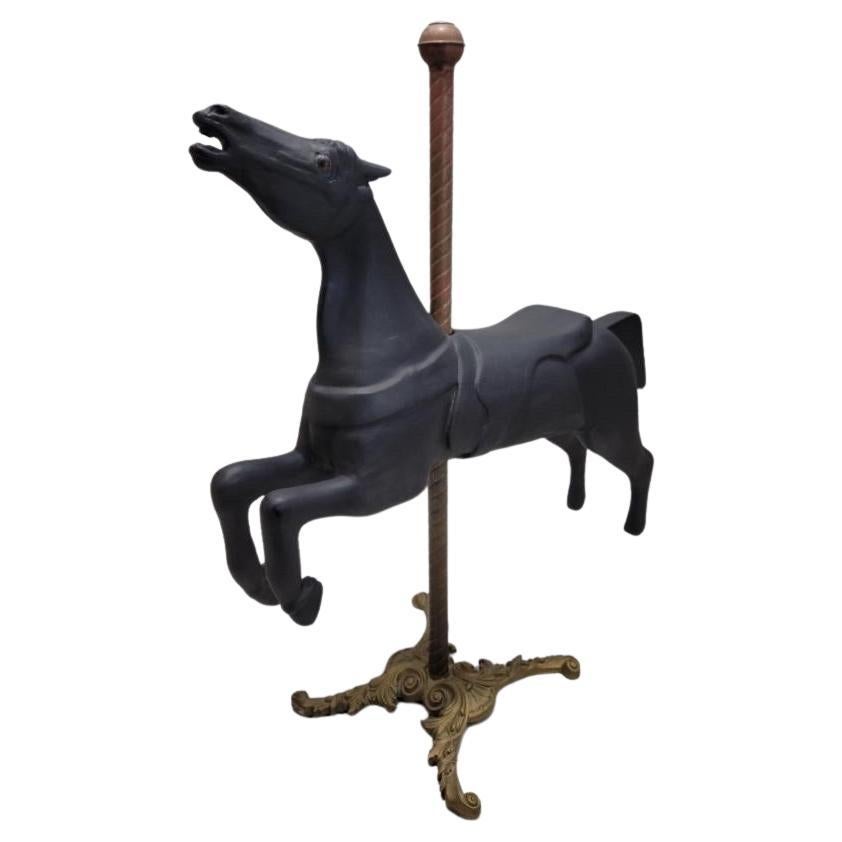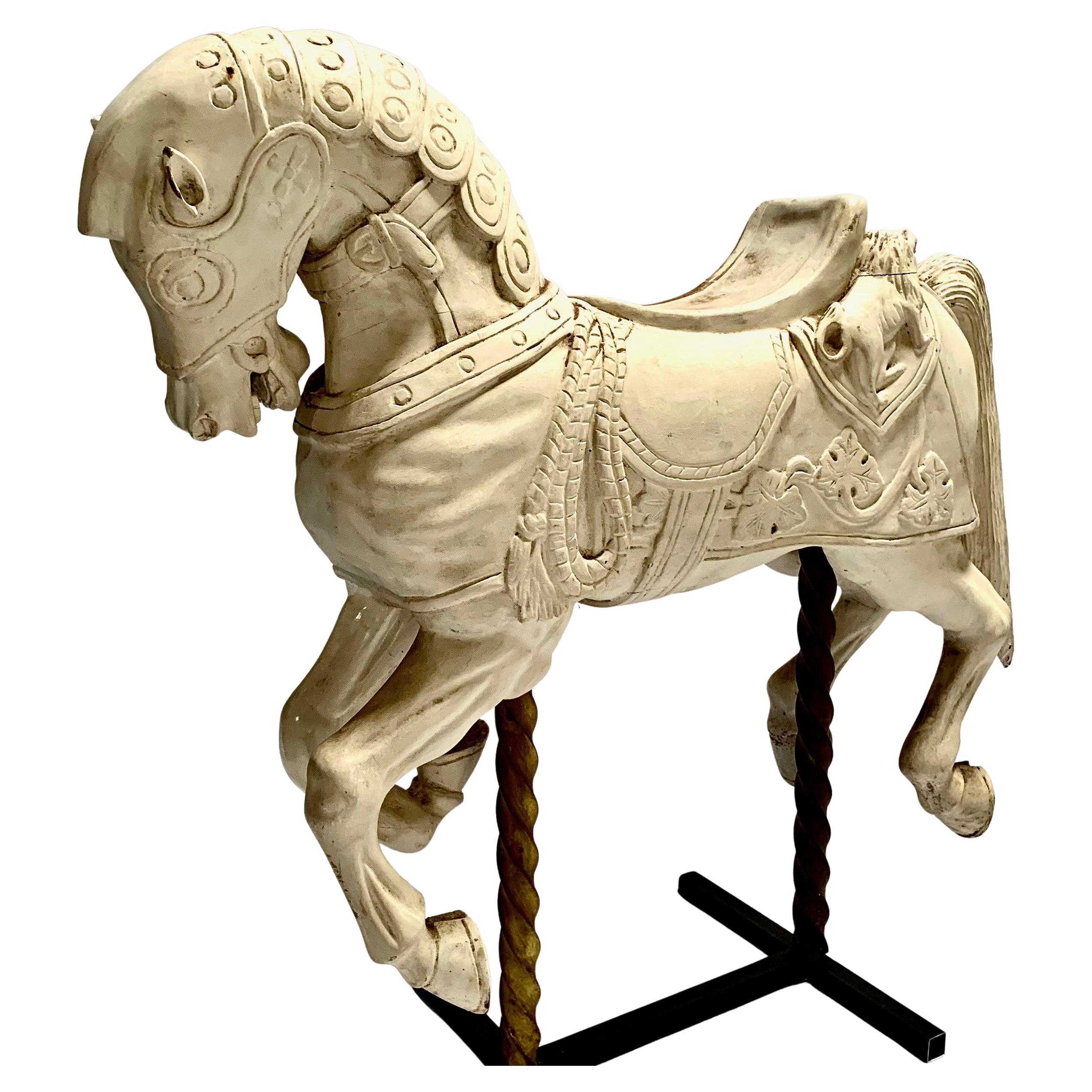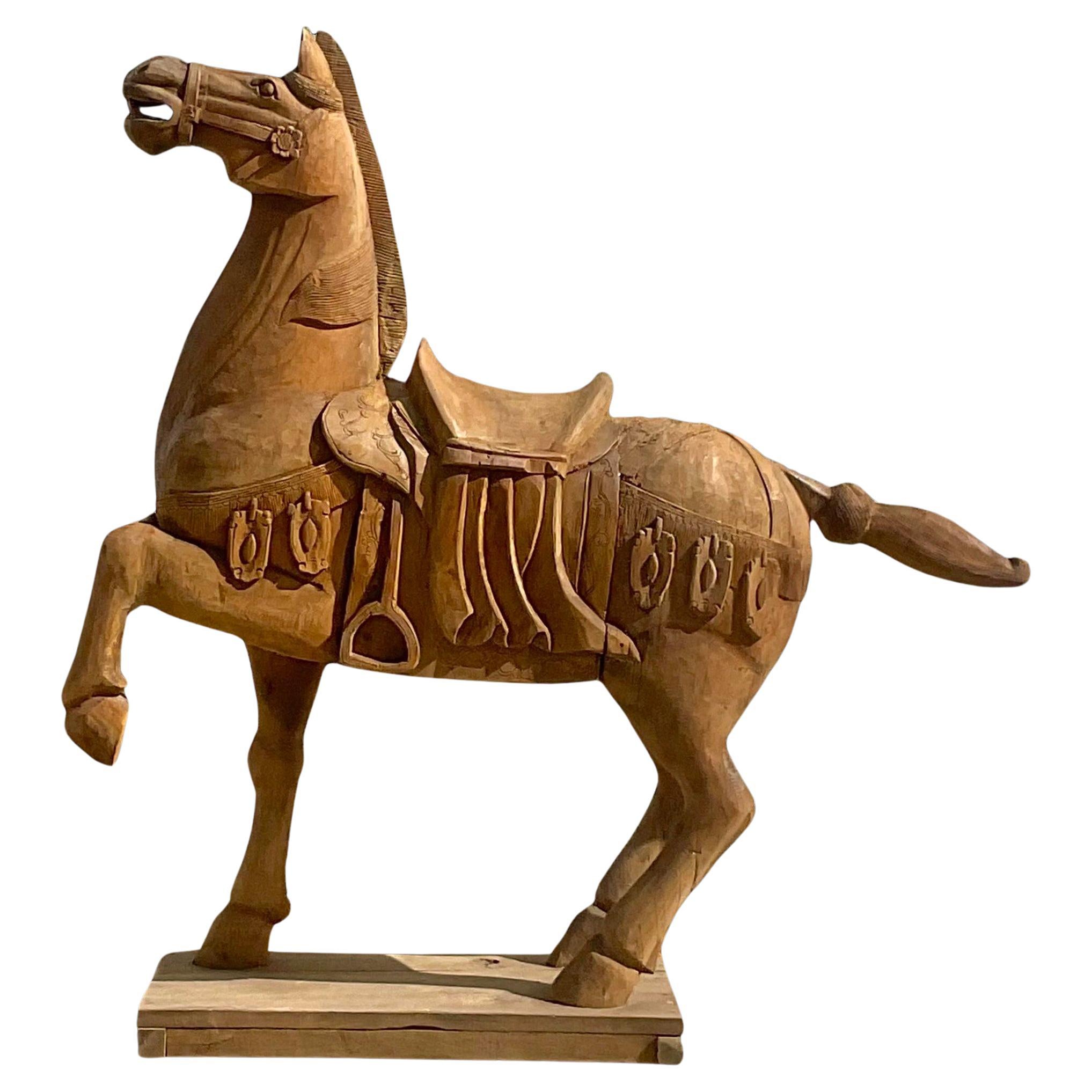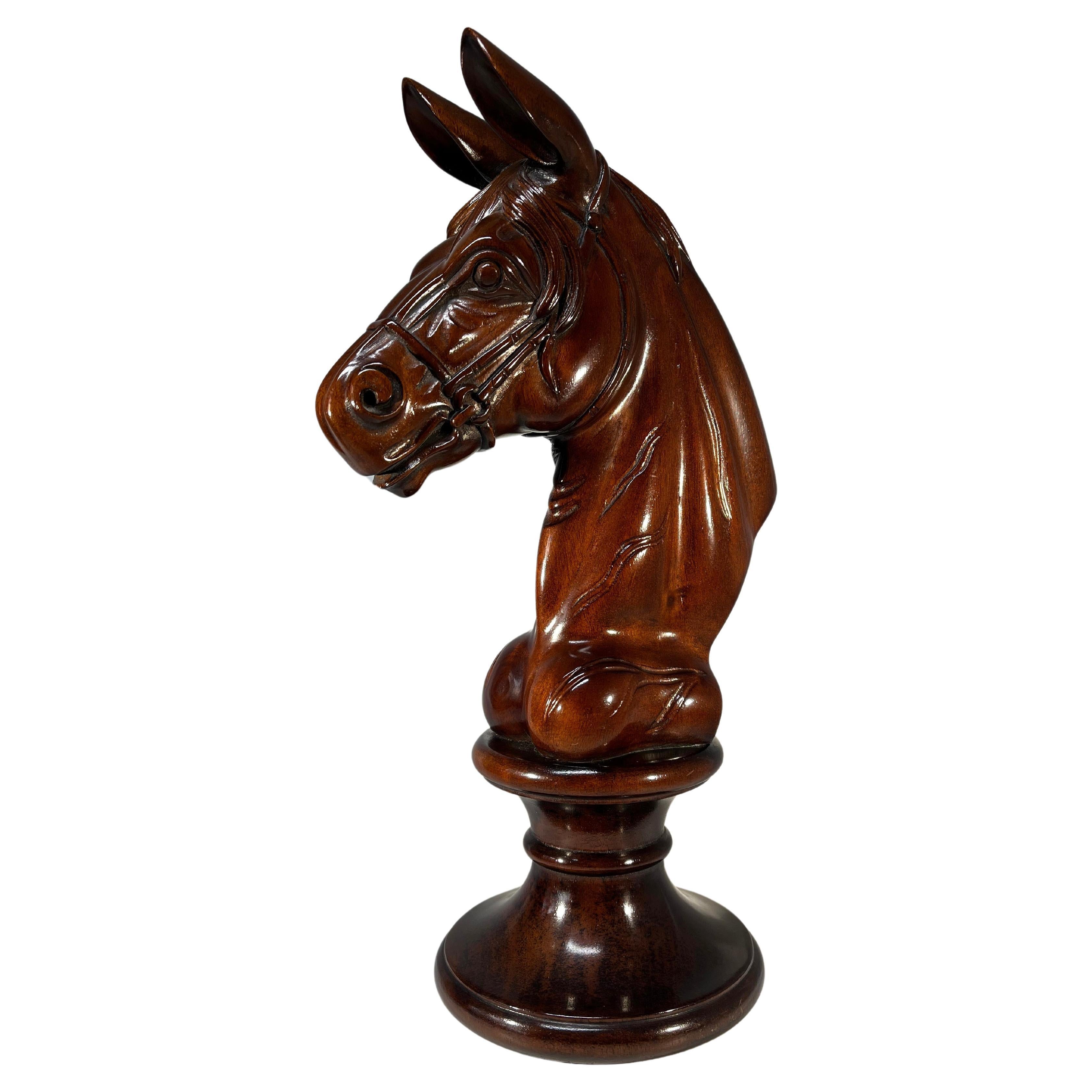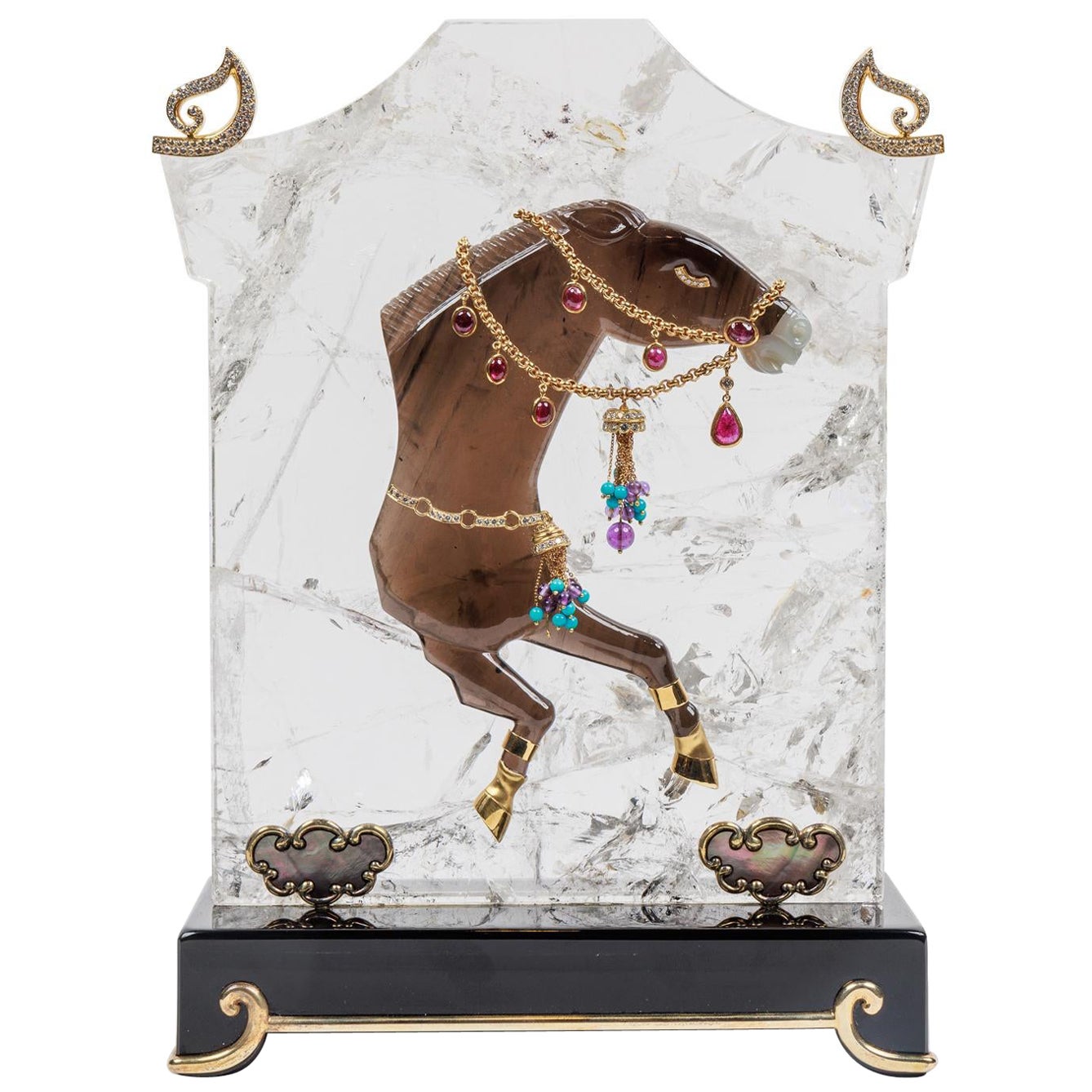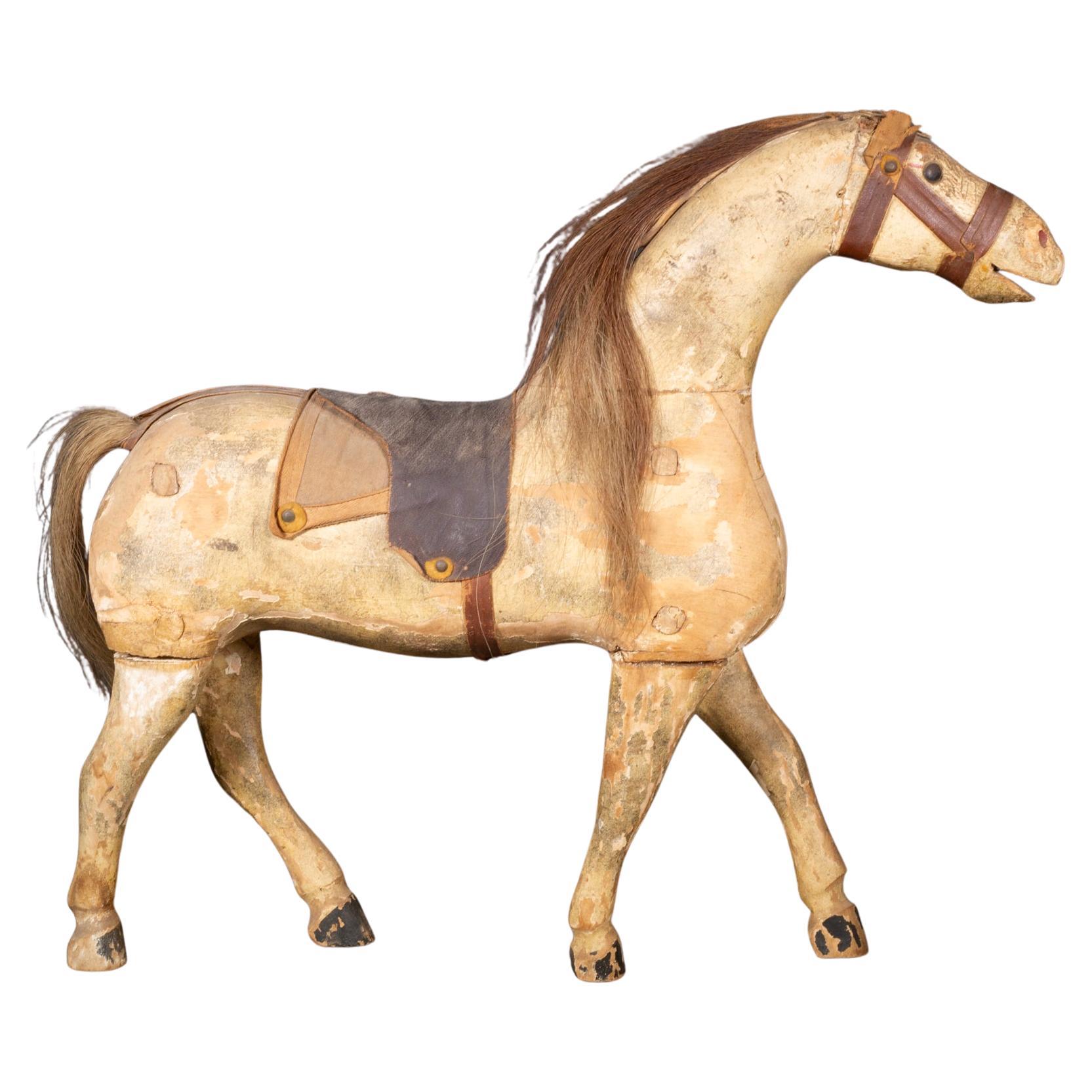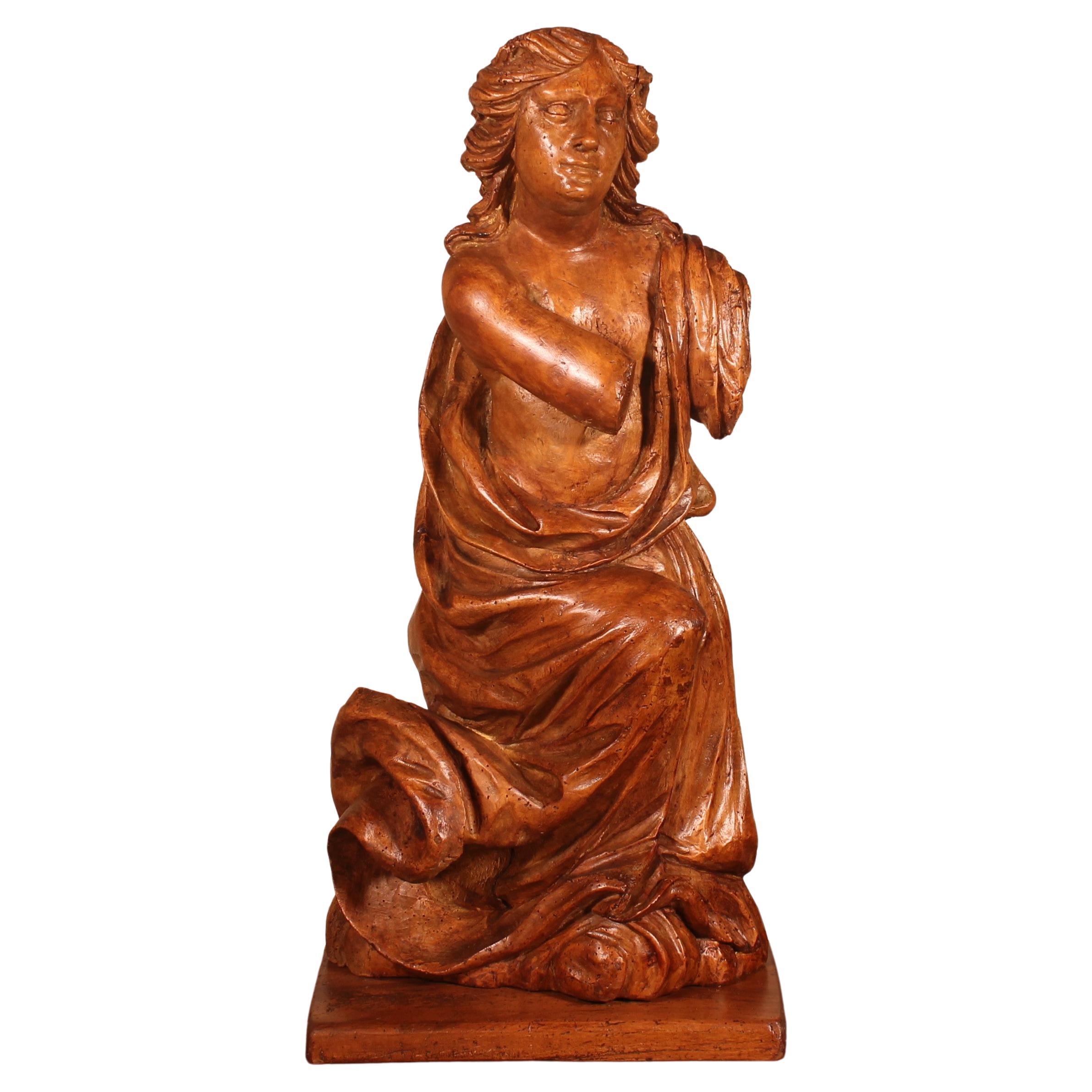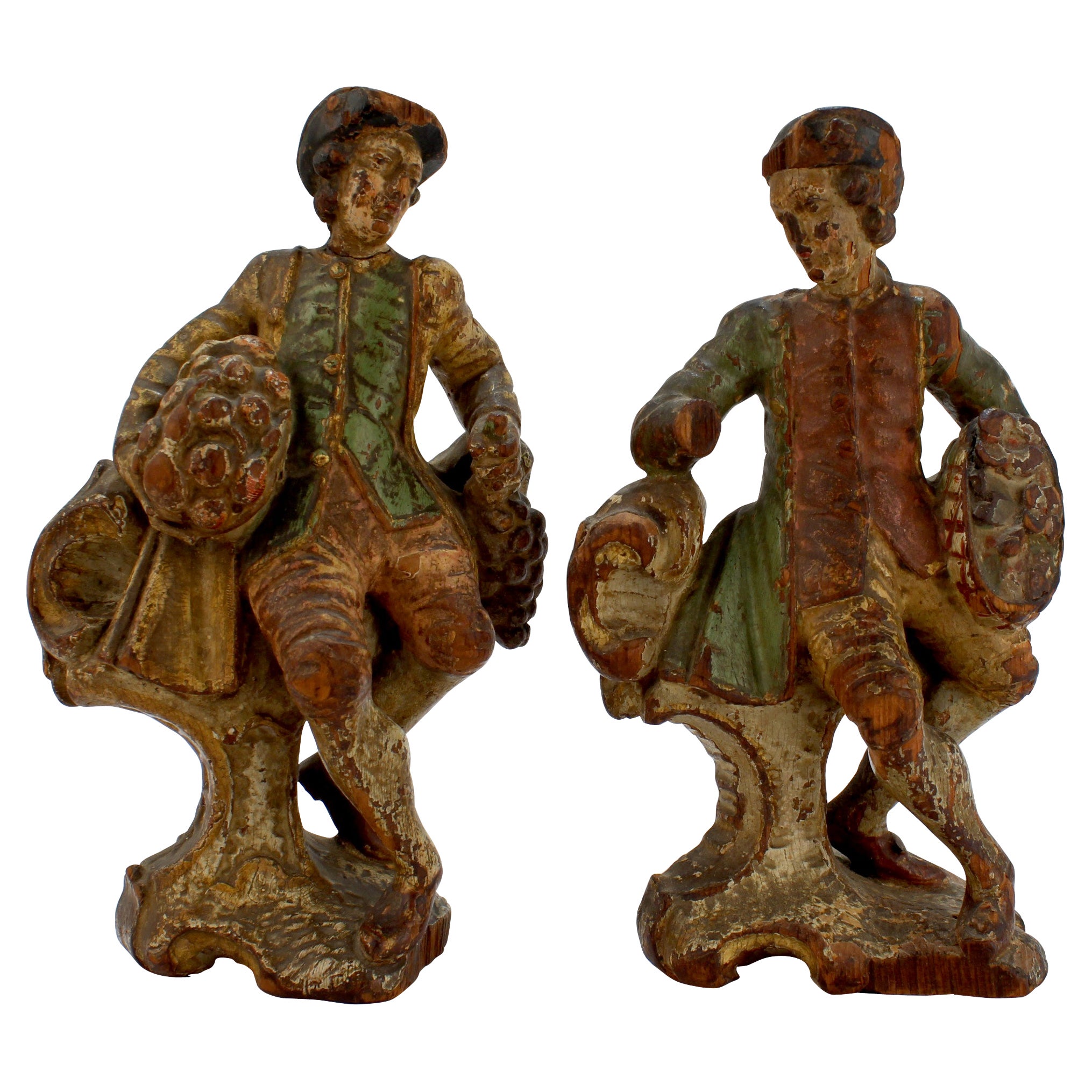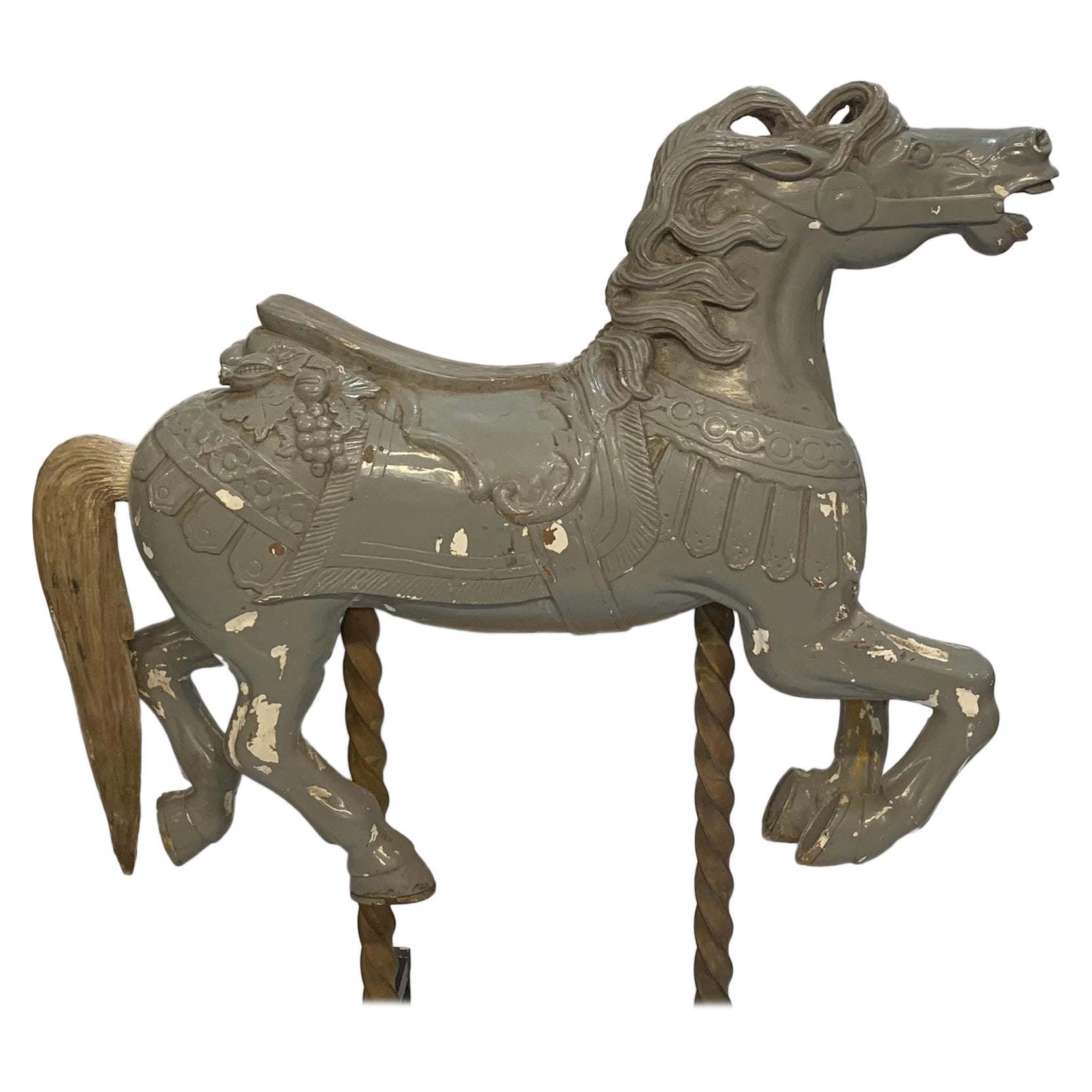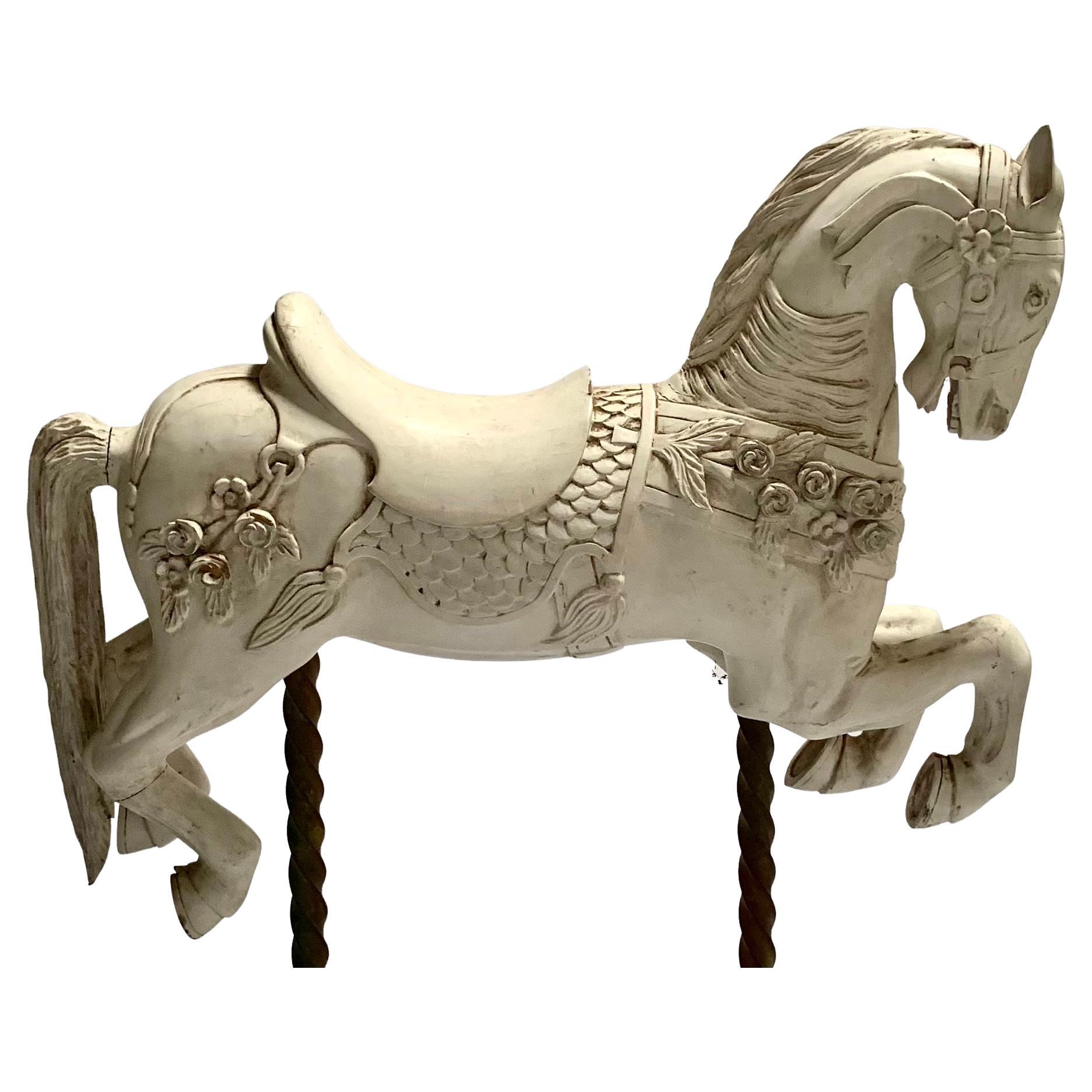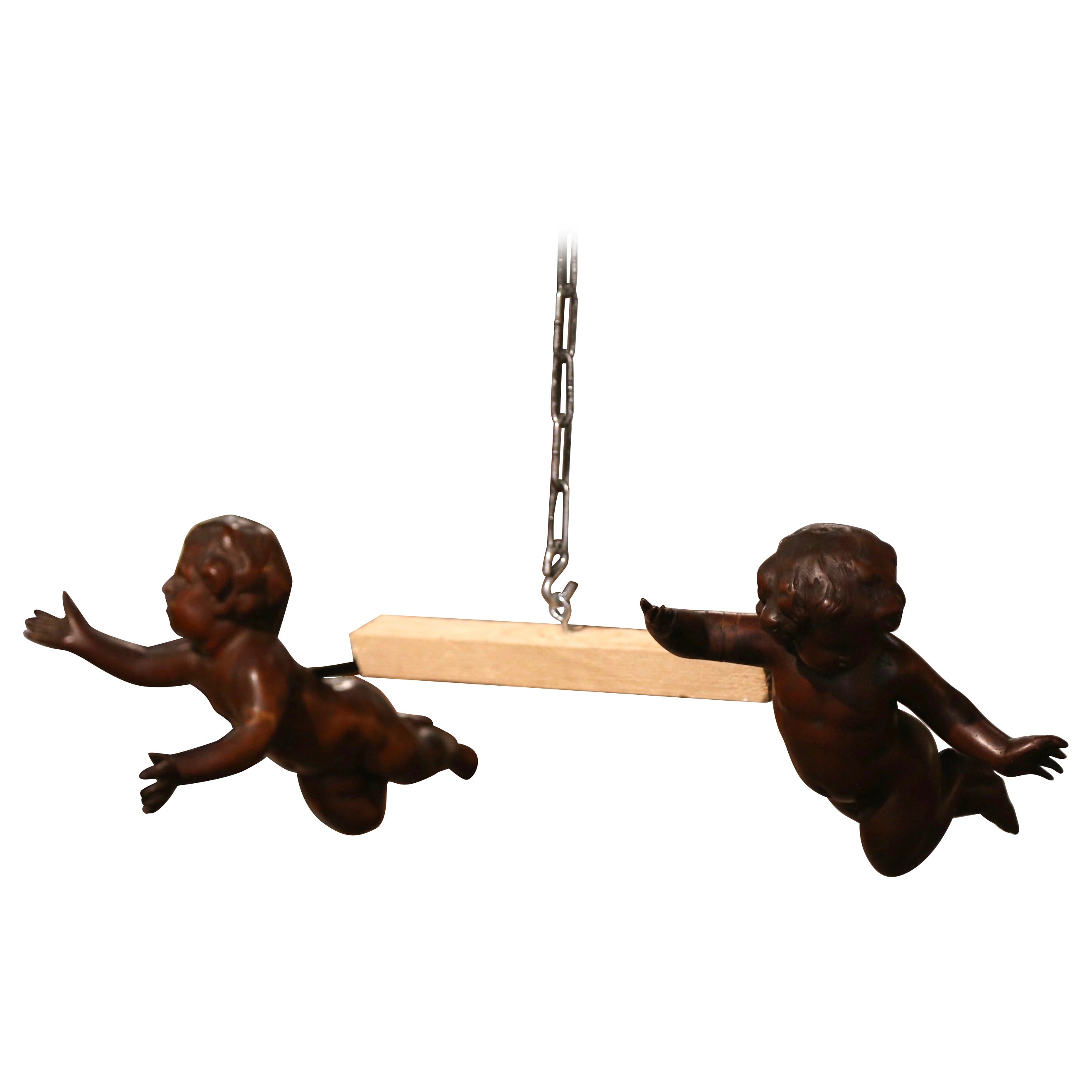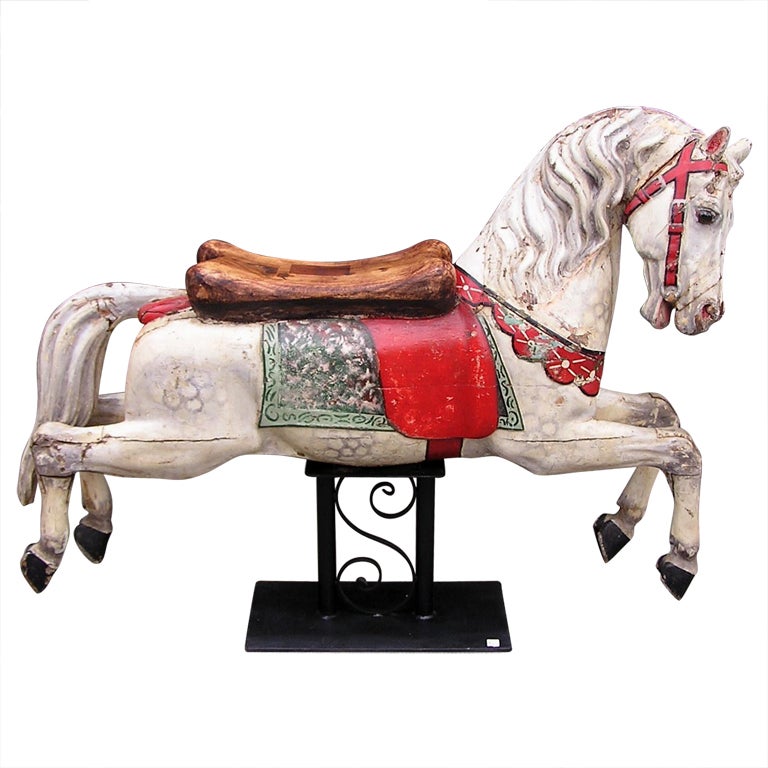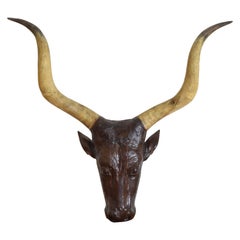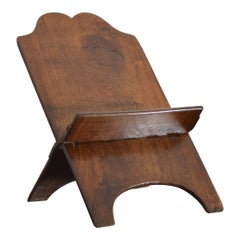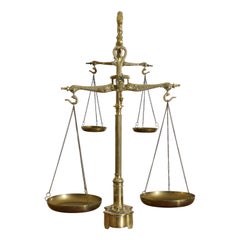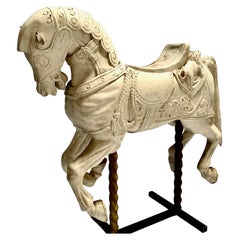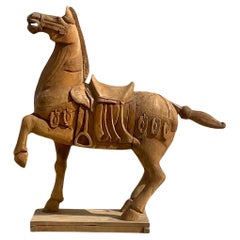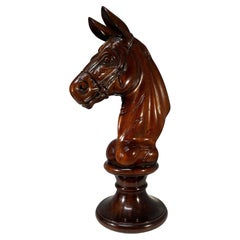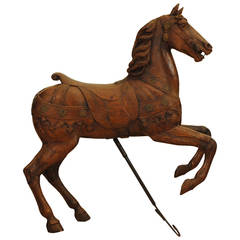
German Carved Walnut and Brass Decorated Carousel Horse
View Similar Items
Want more images or videos?
Request additional images or videos from the seller
1 of 11
German Carved Walnut and Brass Decorated Carousel Horse
$8,400List Price
About the Item
- Dimensions:Height: 50.75 in (128.91 cm)Width: 44 in (111.76 cm)Depth: 11 in (27.94 cm)
- Style:Neoclassical (Of the Period)
- Place of Origin:
- Period:
- Date of Manufacture:2nd Quarter of 19th Century
- Condition:Minor losses. lacking tail.
- Seller Location:Atlanta, GA
- Reference Number:Seller: R61531stDibs: LU82702263332
About the Seller
5.0
Vetted Professional Seller
Every seller passes strict standards for authenticity and reliability
Established in 1993
1stDibs seller since 2007
278 sales on 1stDibs
Authenticity Guarantee
In the unlikely event there’s an issue with an item’s authenticity, contact us within 1 year for a full refund. DetailsMoney-Back Guarantee
If your item is not as described, is damaged in transit, or does not arrive, contact us within 7 days for a full refund. Details24-Hour Cancellation
You have a 24-hour grace period in which to reconsider your purchase, with no questions asked.Vetted Professional Sellers
Our world-class sellers must adhere to strict standards for service and quality, maintaining the integrity of our listings.Price-Match Guarantee
If you find that a seller listed the same item for a lower price elsewhere, we’ll match it.Trusted Global Delivery
Our best-in-class carrier network provides specialized shipping options worldwide, including custom delivery.More From This Seller
View AllFrench Significantly Large & Expertly Carved Walnut Cow Head, 2nd half 19th cen.
Located in Atlanta, GA
The size of this carved head and the detail of the carving accompanied by the size of the horns makes this wall sculpture remarkable, likely made for a boucherie as an advertisement, the horns joined to the head by a wood putty and colored to match, mounted by a slightly hollowed cut in the rear with an iron crossbar, mounts flush...
Category
Antique 1860s French Taxidermy
Materials
Horn, Walnut
Italian Patinated Brass and Marble Architectural Model Inkwell, circa 1875
Located in Atlanta, GA
Cast in great detail in bronze in the neo-Gothic style, the top lifting to reveal three round openings, lacking glass inkwells, resting on a marble plinth base, raised on cast bronze...
Category
Antique 1870s French Gothic Revival Inkwells
Materials
Marble, Bronze
French Louis Philippe Period Walnut Folding Bookstand, ca. 1835
Located in Atlanta, GA
having (when opened) a bow shaped top with a lower book support, the arches at bottom becoming legs, when closed folds flat
Category
Antique 1830s French Louis Philippe Books
Materials
Walnut
French Restauration Period Cast Brass Double Scale & Weights, ca. 1825
Located in Atlanta, GA
In complete and original condition and retaining bright patina this set of scales has a main scale and a smaller upper scale, both supported by dolphin forms hanging on a reeded stan...
Category
Antique 1820s French Restauration Scientific Instruments
Materials
Brass
French Wooden and Iron Cheese Press, circa 1900
Located in Atlanta, GA
Having a double trestle base and a threaded press, the surface with a raised edge and a drain spout.
Category
Antique Early 1900s French Scientific Instruments
French Late Neoclassic Walnut and Brass 2-Door Cabinet, ca. 1840
Located in Atlanta, GA
having a rectangular top with rounded front corners, the case housing two doors, the doors and sides with recessed paneling and brass moldings, raised on tapering feet
Category
Antique 1840s French Neoclassical Cabinets
Materials
Walnut
You May Also Like
Antique Wood Carved American Jumper Carousel Horse
Located in Chicago, IL
Antique Wood Carved American Jumper Carousel Horse
Beautiful early 1900's wood carved classic American jumper carousel horse. The horse has been refur...
Category
Early 20th Century American American Classical Animal Sculptures
Materials
Metal
Old Wooden Juvenile Carved Carousel Horse
Located in Nantwich, GB
Juvenile carved wooden carousel horse carved in the style of Charles Loof.
Lions carved into the back of the saddle.
Requires little restoration.
Started to paint 40 years ago but...
Category
Early 20th Century Unknown American Craftsman Animal Sculptures
Materials
Wood
$5,481 Sale Price
20% Off
Vintage Carousel Boho Carved Wooden Horse
Located in West Palm Beach, FL
An absolutely incredible vintage Boho horse. Monumental in size and drama. Beautiful hand carved detail and gorgeous wood grain. Acquired from a Palm Beach estate.
Category
Late 20th Century Mexican Animal Sculptures
Materials
Wood
Carousel Galloper's Horses Head Carved Mahogany Bust
Located in Rothley, Leicestershire
Kindred to a carousel galloper, a distinguished and elegant mahogany Italian horses head on pedestal
Collectible piece of object d'art for the equine devotee
Circa 1960's
Height 14 i...
Category
Vintage 1960s Italian Animal Sculptures
Materials
Mahogany
$312 Sale Price
65% Off
Mellerio Paris, A French Gold, Diamonds, Silver, and Smoky Quartz Carved Horse
By Mellerio
Located in Queens, NY
Mellerio Paris, A French Gold, Diamonds, Silver-Gilt, Rock-Crystal, Jade, Mother-Of-Pearl and Smoky Quartz, Carved Horse Sculpture, Jeweled Mounted Object.
An extremely rare and unique, one of a kind French gold, diamonds, Silver-gilt, rock-crystal, jade, obsidian, mother-of-pearl, and smoky quartz carved jeweled sculpture "CHEVAUX DE LEGENDE", "A Legendary Horse" by Mellerio, Paris, circa 1991.
Sitting on black obsidian base, the solid rock-crystal slab is finely applied with a carved smoky -quartz and jade horse with a harness mounted in 18k gold, brilliant -cut diamonds, rubies, turquoise, and amethyst chains and pendants. The top columns adorned with 18k gold and brilliant cut diamond pendants, the bottom with gold and mother of pearl plaques. The obsidian base with a plaque engraved: CHEVAUX DE LEGENDE" / N° 05 / MELLERIO DITS MELLER / PARIS / 5003 D
The piece is in excellent condition and comes with a custom made wood case made for transport. It's very elegant and has French hallmarks throughout. A truly magnificent piece.
Measures 10.5" high x 8.5" wide x 4" deep
Founded in France in 1613 by the descendants of Italian immigrants from the Vigezzo Valley in the north of Italy, Mellerio is one of the oldest jewellery houses in Europe. The family business soon attracted the attention of the Royal Court and Marie Antoinette herself reportedly purchased a precious bracelet featuring 7 cameos surrounded by rubies in 1780. Later on, in the 19th century, Mellerio became the official supplier of the French Royal family and the Court of Netherland.
Mellerio creates many jewellery items, all set with rare gems such as peridots, amethysts, aquamarines, citrines and topaz, applying for a patent, the flexible stem, a very supple and light jewellery mechanism. Mellerio remains also well known for their spectacular series of Art Nouveau jewels, created at the beginning of the 20th century, as well as for the creation of trophies rewarding some of the greatest footfall and tennis players of history. In 1993, the jewellery house launched their first watch collection.
Today, Mellerio has stores in Paris, Japan and Hong Kong.
July 14, 1789: this date is known throughout the world as the beginning of the French Revolution. According to a ledger belonging to House of Mellerio, this was also the day that the jeweler sold a golden key to the Comte de Coutance for 10 livres. This ledger, as well as inventories dating as far back as 1768, are the jeweler’s oldest archives. These archives have continued to grow over the years, as the House, established on rue de la Paix in Paris, still lives on today, still in the hands of the same family from Craveggia, in the North of Italy.
The tumultuous history of the Mellerio family in France probably goes as far back as the Italian wars of the Renaissance, but the first official document proving their commercial activity in Paris dates back to 1613. This document is the famous royal warrant awarded by Marie de Medici to a number of Italian families established along the rue des Lombards, including the Mellerios, allowing them to sell “small jewelery items”, therefore granting them a small exception to the traditional monopoly enjoyed by Parisian jewelers. At that time, powerful corporations regulated the operations and customs of Parisian business, but thanks to this exceptional warrant, the Mellerios managed to escape the confines of this framework. Today, this wax-sealed document is kept at the city hall of Craveggia.
From 1613 to the Revolution, the Mellerios lived between France and Italy. The corporations tried many times to put an end to their trade privileges, but all in vain, as a dynasty of sovereigns renewed the warrant. Always marrying and often retiring in Craveggia, the Mellerios continued to maintain their jewelry business in Paris. At first, they did this without a shop. Wearing backpacks (wooden boxes divided into small compartments where jewels were kept), they would tour town fairs around Paris and royal castles.
This is how Jean-Baptiste Mellerio (1765-1850) is said to have sold a bracelet set with rubies and Antique cameos to Marie-Antoinette, which still exists today. Many elements seem to prove the veracity of this anecdote. The queen was particularly fond of cameos, which cover the entire background of her famous jewelry cabinet, and ruby was her favorite stone after diamond. The famous bracelet, reacquired a few years ago by the House of Mellerio, is indeed an 18th century jewel, set with antique cameos representing the profiles of Roman emperors. Two branches of the family were operating in Paris during this time, under the reign of Louis XVI: that of Jean-François (1746-1828), the paternal ancestor of the current Mellerios, and that of Jean-Baptiste (1765-1850).
The French Revolution forced them to return to Italy. However, both Jean-Baptiste and François Mellerio (1772-1843), who was the son of Jean-François, were eventually able to return to Paris after the founding of the Consulate. Jean-Baptiste opened a shop at the Iron Crown of rue Vivienne, and François opened his at the Palais des Tuileries, rue du Coq Saint-Honoré. His well-organized order books give an idea of his high-ranking clientele during the “Old Regime”, among which were the Comte and Comtesse Octave de Segur, the Marquise (later Duchess) de Tourzel, former governess of the royal children, and her daughter, the Comtesse de Bearn, the Craufurds -who organized the flight to Varennes, the Duc and Duchess de Gramont, the Comtesse de Boigne, and Madame de Souza, Talleyrand’s mistress.
We also see the names of the imperial family: Empress Josephine, the Queen of Holland, Princess Elisa, Caroline and Pauline. At that time, the House of Mellerio specialized, among other things, in the trade of antique cameos, a newly fashionable genre of jewel that captured the imagination of all the princesses and noble women of the time.
The years of the Restauration and July Monarchy were among the most glorious. The Bourbons were back on the throne, and the clientele of the House of Mellerio had regained its former wealth. Mellerio supplied Louis-Philippe, Duke of Orléans, as well as his mother, wife and sister, with sumptuous jewels, including a set of emeralds made piece by piece, while the Duke of Bourbon, last prince of the House of Condé, offered diamonds to his mistress, the scheming Baronne de Feucheres, and Monsieur de LaFayette also bought cameos for one of his granddaughters. For the first time, Mellerio ventured into the world of arts in 1815, when Carlotta Grisi, a famous dancer who created Giselle, as well as an actress named Rachel, bought jewels at the Mellerio store on rue de la Paix.
1848 marked a new turning point. France once again became a Republic. François Mellerio handed the company over to his son, Jean, and the latter decided to travel to Spain to build a new clientele. He later became one of the jewelers of the royal family, and met Eugénie de Montijo, who remained a faithful client when she became empress of the French people. The Imperial years were lavish. During the Second Empire, Paris was a pageant of crinoline dresses designed by Worth, while jewels by Mellerio, Worth’s neighbour on the rue de la Paix, adorned the noble women of the Tuileries court.
The Empress bought pearls. Mathilde Bonaparte...
Category
20th Century French Mounted Objects
Materials
Rock Crystal, Jade, Quartz, Gold, Silver
Mid-Late 19th c. Carved Horse c.1850-1890
Located in San Francisco, CA
ABOUT
A mid to late 19th century carved wooden horse with horsehair mane and tail, fabric ears, saddle, harness and nail-head eyes.
CREATOR Unknown. Made in Germany or the USA....
Category
Antique Mid-19th Century American Industrial Toys and Dolls
Materials
Wood, Fabric
Recently Viewed
View AllMore Ways To Browse
Carousel Horse Sculptures
Carved Carousel Horses
Antique German Carousel
German Carousel Horse
19th Century Carousel Animals
Entryway Sculpture
Hand Carved Wooden Animals
Monkey Object
Rooster Paint
Wegner Bronze
Glazed Dog
Large Murano Sculpture
Wooden Lion
Black Bird Sculptures
Danish Wood Sculpture
Dolphin Art
Antique Pheasants
Bronze Sculpture Animal Head
